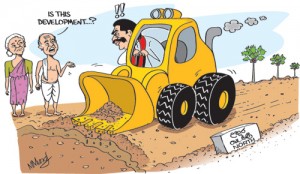Columns
Harnessing the diverse economic potential of the North
View(s): Although five years have passed since the end of the war, the full development potential of the North and East has not been harnessed. Most investments have been for rebuilding and reconstruction of infrastructure and housing – areas that were indeed priorities and prerequisites for economic development. Now that much has been achieved in developing infrastructure, a new focus and long-term investment plans are needed for the economic development of these two regions.
Although five years have passed since the end of the war, the full development potential of the North and East has not been harnessed. Most investments have been for rebuilding and reconstruction of infrastructure and housing – areas that were indeed priorities and prerequisites for economic development. Now that much has been achieved in developing infrastructure, a new focus and long-term investment plans are needed for the economic development of these two regions.
The economic development of this region could make a vital difference not only to the region, but to national economic development. A development strategy has to be mapped out and effectively implemented soon to harness the potential in agriculture, industry, services through new enterprises. Economic development could provide gainful employment for youth in particular and improve incomes and livelihoods in the region.
Preconditions
An equitable, durable and permanent political settlement must be arrived at so that the conflict of the past is laid to rest and economic development emerges as the priority. The provincial administration must play a dynamic role in economic development rather than be preoccupied with political issues.
Vital tasks such as resettlement of displaced families, rebuilding of devastated areas and reconstruction of economic and social infrastructure have been fairly successfully accomplished. The development of the road network and the resumption of the Colombo-Jaffna railway can contribute significantly to the development of the North.
 The Northern economy
The Northern economy
About 25 per cent of the economy of the north is derived from agriculture. Agriculture was one of the worst affected activities in the North. Paddy and food crops could not be grown in many areas owing to the shelling, mines and difficulties of obtaining agricultural inputs. Furthermore, marketing of agricultural produce was severely restricted as produce could hardly move into other parts of the country. This resulted in crops such as potatoes, onions, chillies and other food crops being grown in other parts of the country.
New forms of farming
The agrarian economy of the future would have to be much different. Since labour shortages for traditional small scale agriculture are a constraint, new perspectives to harness the fertile uncultivated large extents of land are needed. Mechanised large-scale farming enterprises that could invest in research and irrigation should be the new agricultural development strategy.
The Northern Province grows a variety of food crops and has a large extent of lands that could be used for the cultivation of valuable cash crops. Inadequate rainfall and irrigation facilities are serious constraints. There are two strategies to overcome this. One is to obtain water by digging wells, tube wells, rainwater harvesting and irrigation. Recent rainfall patterns, water availability and irrigation methods and soil conditions must be studied to determine suitable crops to be grown.
Large farms managed by companies for growing cash crops would be the most suitable mode of production as they would have capital and technology to develop these lands. Several companies have proven their capacity for successful cultivation of crops, including new crops and crop varieties. Such firms could develop these lands productively for export crops too. Unfortunately there has been a traditional reluctance of governments to give land to private firms.
The other parallel strategy is to grow crops that require less water and can be rain fed. These include Palmyra, drum sticks (murunga), coconut and mangoes. Markets for such produce could be expanded by agro-processing industries and links with markets in other parts of the country. The Government should give large extents of land on long lease to agribusiness ventures that can make the investment required for such large scale cultivation of crops. The export potential for these crops must also be explored.
Agriculture in the North must be transformed into one that is more productive, expanded into new crops, mechanised and large scale and complemented by agro-processing.
Fisheries
Fisheries were severely restricted by the prohibition of fishing in the security zone. Currently, the problem of Indian fisherman poaching has reduced the fish stock available to fishermen in the North. This is no easy problem to resolve. Meanwhile, the capacity for fishing must be enhanced by investments in advanced fishing boats that could increase the output of fisheries.
Industrial development
The few industries in this region were closed and in ruin or disrepair. Some of these could be revived and new ones established. The revival of the Kankesanthurai cement plant, the Paranthan chemical and the Valaiachchenai paper industry are among the industries that could be revived. However, their viability and costs and benefits must be evaluated before large investments are made. There are plans to develop two salterns too.
A new industrial plan is needed for establishment of new viable enterprises. The best course of action is to get foreign investors to establish new export-oriented industries.
The private sector should lead the development effort in the North. The best way is to establish Economic Processing Zones (EPZs) in these areas with links to the proposed Trincomalee-Kilinochchi EPZs.
They could easily be modelled after the existing ten EPZs in the rest of the country. They could attract both FDI and local investors and provide much needed employment opportunities and export earnings.
The development of the harbour and airport, improvement of roads and bridges and the railway to Jaffna would contribute much to the industrial development of the North.
Tourism
Tourism resurgence provides new opportunities for enterprises in Jaffna. However tourist facilities have to be improved considerably by way of better and more accommodation, restaurants, efficient service and cultural activities.
Future
The northern economy of the future cannot possibly be a replica of the past. Much has happened globally. There has been an economic transformation in the South and the aspirations of youth in the North are vastly different to those of three decades ago.
The technological revolution and the vast strides in information technology offer new developmental opportunities for a much more services oriented economy. The development of education and technological skills, such as information technology, provides the means for new avenues of productive employment. EPZs would be an important catalyst for modernization of the North.

